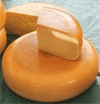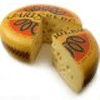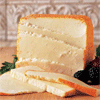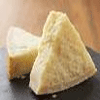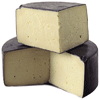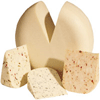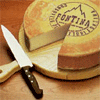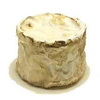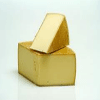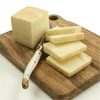Cheese is believed to have been discovered way back in the time around 3000 BC. However, the first cheese factory in the United States wasn’t until the early 1850’s when railroads allowed for fast and efficient transport of milk and cheese. The first built, right here in New York. And by 1865, industrial production skyrocketed, with more than 500 factories in New York alone.
How does milk become Cheese?
There are four main steps in making cheese: Coagulation, Cutting, Shaping and Ripening.
Milk is about 85% water and contains protein, fat, vitamins and minerals; cheese forms from these nutritious solids
Milk starts to become cheese naturally; as it starts to spoil, its liquids and solids separate as the bacteria consume lactose (milk sugar) and produce lactic acid. The acidity makes the milk curdle or coagulate as its solids clump. This process can be accelerated by adding bacterial cultures which is commonly done for larger and faster production. For most cheeses, the curd is cut during coagulation by utilizing a cheese harp. The curds are then removed from the coagulation vat with either a ladle or cheese cloth which allows much of the liquid (whey) to drain off. The curds are then shaped; either placed directly into molds, or drained, stacked, kneaded, or stretched. After shaping, many cheeses undergo ripening (also known as curing or aging). Some are loosely wrapped or covered with wax; others are bathed in a salt bath or dry-salted, wherein salt is rubbed into their surface. The salt begins to dry the cheese and often stimulates rind formation. Cheese surfaces may also be washed, rubbed, brushed, treated with mold or bacteria, or even pierced to allow airflow and internal mold development. After the ripening period – which can vary from a few weeks to years – the cheeses are ready for eating.
Nutritional Information:
Nutrients found in cheese aid in cell maintenance, help preserve skeletal structure and promote proper nervous system function. Milk’s main nutritive value comes from its solid matter – protein, vitamins, minerals and fat – which cheese provides in a concentrated, more easily absorbed form. Cheeses can contain up to 36% protein and are loaded with vitamins (A, B – complex, D, E) and minerals (Calcium, Magnesium, Phosphorus). The fat in cheese is useful the absorption of fat-soluble vitamins (A,D,E,K).
Classification of Cheese:
Cheeses are generally classified by texture, which differs according to moisture content.
- Fresh Cheeses: Like organic cottage cheese and Cream cheese are barely ripened if at all, retain much moisture, and taste mild and creamy.
- Soft Cheeses: Like Brie and Camembert, have a creamy, sometimes runny texture.
- Semi-soft Cheeses; Like Muenster and Havarti, are sliceable and have a mild, pleasant flavor.
- Semi-hard Cheeses: Like Gouda and Edam have often been pressed; they become firmer and develop deeper flavor over time.
- Hard Cheeses: Like Emmental and Cheddars, are ideal for slicing. Textures of hard cheeses vary, and their full, sharp flavors become more pronounced with age.
- Extra-hard Cheeses: Like Parmigiano Reggiano, are brittle and grate well. Their very low moisture content creates concentrated, rich flavors.
Pasteurization vs Non-Pasteurization:
Pasteurization is the process of heating milk to kill germs in one of two ways. One, milk is held at a high temperature briefly, or two, milk is heated at a lower temperature for a longer time, thus killing fewer beneficial bacteria. Pasteurization also attacks beneficial bacteria and diminishes vitamins, resulting in a less nutritious, often less flavorful product. In the United States, unpasteurized cheese can be sold only if it has been aged for more than sixty days – another process used to reduce unwanted bacteria.
Processed Cheese:
In order to make cheese easier to produce, transport and keep longer, companies worked to come up with ways to make this happen. Through trial and error they found that adding emulsified salts to cheese they could meet their goal. Today, processed cheese must have at least 51% of real cheese with the other 49% being additives such as preservatives, cream, butter, seasonings, colorings and water.
Flavored Cheese:
To add some pizzazz to cheese, many types of flavors have been added to give a diverse taste option. Flavorings can be single items or a blend of herbs, spices, seeds, nuts, fruits, garlic, onion, peppers, and horseradish to name a few. There are also smoked cheeses which are distinguishable by their brown covering (which you eat). Smoking can be either from natural smoke, artificial smoke flavor or a combination of both. Another way to achieve flavored cheese is to layer different kinds of cheeses which will offer a simultaneous contrast or complimentary taste.
Storing Cheese:
Cheese is best stored at a temperature of 50 – 60 degrees and about 90% humidity. To best preserve cheese, follow a few guidelines. Avoid temperature extremes, do not expose to warm air for long periods, store near the top in your refrigerator or in the cheese drawer, or if you’re storing cheese in a restaurant, consider commercial refrigeration services to ensure the best conditions possible. Be sure to wrap loosely in waxed paper, foil or plastic as cheese must breathe. If your top-shelf is quite low in your refrigerator, you may want to consider getting one that has various compartments to suit your cheese loving habits! You could find your perfect refrigerator at https://breezerfreezer.com/. Cheese can withstand temporary changes in temperature. So don’t worry if you are traveling and want to take some cheese with you. When you get to your destination, just put the package in the refrigerator and it will be fine.
Mold:
All cheeses will mold if not properly stored. That doesn’t mean the cheese is bad. Certain cheeses are actually encouraged to mold in order to break down the curd and create a more robust flavor. Soft cheeses such as Brie, Camembert and Cambozola have a white bloomy or flowery rind due to their surfaces being sprayed with penicillium candidum spores to become soft and creamy. Further, mold is essential for blue-veined cheeses in which strains of penicillium are introduced into the cheese. If however, mold forms on cheese in your refrigerator, simply trim away the affected area and re-wrap in new packaging. The cheese itself is still good and may even be better as mold helps age cheese.
TYPES OF CHEESES
CHEDDAR CHEESE:
Cheddar cheese emerged centuries ago in Britain. Cheddar is unique to all other cheeses because of the process of how it’s made which is referred to as “cheddarization”. Instead of being mechanically pressed to compress the curd and create a denser cheese, cheddar curds are cut up, piled atop one another, and rearranged often. The weight of the curds drains the whey from neighboring curds thus ending up with a hard and sliceable cheese. Cheddar cheese is also naturally a white cheese. The yellow cheddars that you may see are dyed with annatto, a pigment from a tropical tree.
FLAVORED CHEDDARS:
A New York white cheddar that contains herbs, seeds, flavors and meats. Dill, Garlic, Horseradish, Bacon Horseradish, peppercorn, sundried tomatoe & basil, buffalo wing, pepperone, jalapeno
BLUE CHEESE:
Blue cheese has blue-green marbling, a pungent aroma and a strong complex taste. The coloration is caused by mold which is created by the addition of penicillium spores to the curd and then later when the cheese is pierced with wires to allow air to enter. The blues tend to age from the inside out allowing for full flavor development as the mold breaks down the cheese. Most of the blues are semihard with a range of textures. Roquefort is made from sheeps milk and has a more crumbly texture while Gorgonzola is from cows milk and is softer. Cambozola, also cows milk is a creamy blue that has the bloomy rind. The intenseness in flavor is related to the age. The older, the stronger.
EMMENTAL:
Emmental is the classic Swiss cheese nicknamed mouse cheese because of the holes it has throughout. Those holes form during ripening by carbon dioxide bubbles that formed from bacteria being added to the curd. The air cannot escape thus the development of the holes. Emmental, with a fresh nutty flavor is great for slicing for sandwiches or for a cheese course.
FETA:
The crumble ingredient of Greek salads acquires its distinctive strong, salty taste by soaking for at least a month in a brine solution. Originally, Feta was made from pure sheeps milk. Cows milk can be substituted but will change the pure white color of the cheese. Today, a combination of milks are usually used but you can still get the pure sheeps milk Feta.
GOUDA:
Holland ‘s best cheese which is a semi-firm cow milk cheese perfect for table eating. Gouda is usually sold and eaten young as a mild, buttery cheese. Gouda’s are also usually kept in wax with the different colors of wax meaning different flavors. Red wax is the most seen here along with the brown for smoked Gouda.
GRUYERE:
A Swiss cheese that is often mistaken for Emmental. However, Gruyere has smaller holes, made from unskimmed milk which makes it smooth and great for cooking, especially fondues since it rarely separates or becomes stringy.
HAVARTI:
A mild cheese from Denmark, has a buttery with a slightly tangy flavor. It is great for slicing and perfect on a sandwich. It is usually a young cheese but can be aged for a sharper flavor.
JARSLBERG:
A Norwegian cheese reminiscent of the Swiss cheeses but without the holes. Jarlsberg is a very mild and balanced cheese made by integrating traces of nuts and flowers etc that makes it unique.
MUENSTER:
A semi-soft cheese that originated in France but now made in other countries as well. Muenster is made with pasteurized milk today and is coated with a liquid during ripening to encourage the growth of bacteria that gives it the characteristic orange-red outer layer, slightly pungent aroma, and a resonant flavor. This cheese is great for slicing and was traditionally served sprinkled with cumin seeds with fennel or caraway as an alternative.
PARMESAN:
The most famous of the extra-hard cheeses, usually from Italy. Parmigiano Reggiano must be made from milk collected from April to November from cows that have only been eating vegetation such as clover and Lucerne. The texture is grainy and creamy, has an oily mouth feel and has a pleasant spicy to fruity after taste. Because of the extreme flavor and hardness, Parmesan is perfect for grating over many foods, salads and soups.
PECORINO ROMANO:
Another cheese that originated in Italy but is also made in the United States and other countries. This is a sheeps milk cheese and is an extra-hard cheese used mostly for grating. Other types of Pecorino are also seen such as Pecorino Toscano, which uses different milk mixtures, and Pecorino Siciliano, which has bits of pepper mixed into the curd for a sharper, spicier taste.
SHEEP AND GOAT MILK:
Sheep and goat milk cheeses are stark white in appearance because the animals milk lacks carotene that is found in cows milk. These cheeses tend to have stronger aromas and flavors as well. Sheep milk has up to three times the amount of butterfat than cows milk thus making a richer cheese. Examples of sheep milk cheeses are: Manchego, Feta, and Roquefort. Goat cheeses are often marketed under the name chevre which is the French word for goat and are usually sold young. One of the most common is the goat cheese log which is coated with herbs and spices.
MANCHEGO:
A Spanish cheese made from sheep milk that is traditionally enjoyed before dinner which compliments many of the tapas served in Spain. Manchego is either washed during maturation or soaked in olive oil that gives the cheese its brown rind and sometimes a very dark brown to almost green rind. The interior is the classic white cheese that is common to sheep milk which makes for a beautiful contrast to the rind when served as a wedge.
ASIAGO:
Once made of sheep milk, is now made mostly from cows. There are basically two types of Asiago. One is a whole milk cheese that is a semisoft with small holes throughout. This cheese is usually used for slicing at a young age. The second kind has a mixture of skimmed milk along with the other milk which becomes a semi-firm cheese. With age this cheese becomes harder and is commonly used for grating over food. Both cheeses are smooth in texture and have a sweet flavor that becomes more flavorful as it ages.
MONTEREY JACK:
Discovered in California in the early 20 th century, Monterey Jack has been a popular cheese all over the US. The cheese is a clean white softer cheese that is mild with a somewhat buttery flavor. A variation of the Monterey Jack is the Pepper Jack where hot chili peppers are added to give a little bite. Monterey Jack is a common cheese used in Mexican dishes.
FONTINA:
Mostly know for its melting quality, is used in fondue and raclette. It even does well for grilled cheese sandwiches. It is an Italian cheese made with milk produced generally during the warmest months when the Alpine vegetation is flourishing. The result is a blend of flavors of creamy sweetness and mild spiciness.
BRIE:
The classic cheese from France is a soft, creamy, almost velvety in the middle cheese with an extreme buttery, nutty richness. The rind of Brie is matured by the addition of penicillium candidum. This mold softens and flavors the cheese from the outside in. You know you have good Brie when you get an aroma of mushrooms or freshly turned dirt. Brie is often served as a dessert cheese but is also very popular as an appetizer on crackers or bread with chutney or pepper jelly. Figs and pears go great with this cheese.
TRIPLE CREAMS:
Always a dessert cheese due to its remarkably rich flavor with a little tang. Some triple creams are meant to be consumed immediately such as Mascarpone, while others age for a few weeks and have the smooth velvety texture. Two of those are Saint Andre and Brillat-Savarin. If you want something with a bit more bit, go for the Cambozola that is a bloomy rind blue cheese.
APPENZELLER:
Also know for its melting ability, this cheese is used for fondue or raclette along with Fontina, Emmental, and Gruyere. Coming from Switzerland, it has a significant nuttiness with a creamy feel coming from repeated brushing while aging with cider, salts, herbs, spices and yeast. This cheese can also be served on a cheese board to balance the softer milder cheeses.
LIMBURGER:
Known as the “stinky cheese” Limburger was discovered in Belgium by monks. The powerful pungent aroma comes from surface bacteria used to age it. The inside has a firm center with a softer riper layer around it. Be aware, this is not for the lightweight, and don’t put it in the fridge without sealing it in plastic. A similar cheese know as Bierkase is a little less pungent, made for those who cant quite take the real Limburger.




